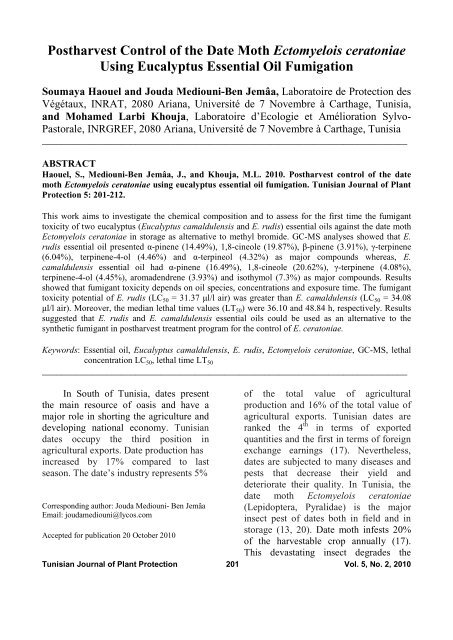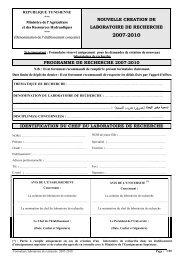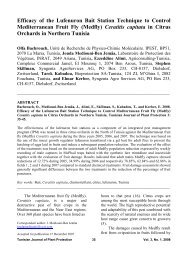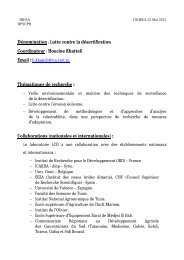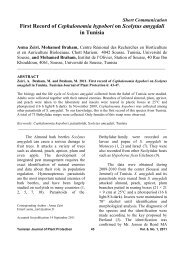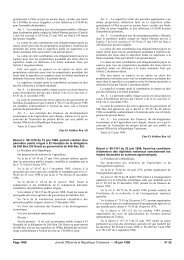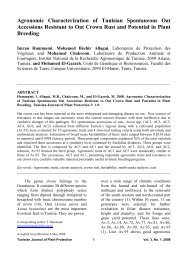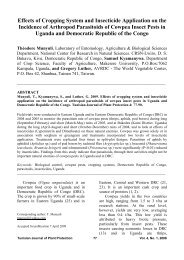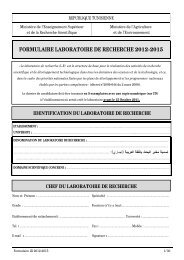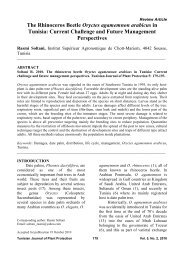Postharvest Control of the Date Moth Ectomyelois ceratoniae ... - Iresa
Postharvest Control of the Date Moth Ectomyelois ceratoniae ... - Iresa
Postharvest Control of the Date Moth Ectomyelois ceratoniae ... - Iresa
You also want an ePaper? Increase the reach of your titles
YUMPU automatically turns print PDFs into web optimized ePapers that Google loves.
stored dates and causes weight loss anddowngrading <strong>of</strong> <strong>the</strong> commercial value <strong>of</strong><strong>the</strong> fruit (2, 14).<strong>Date</strong>s intended for export undergo<strong>the</strong> process <strong>of</strong> conditioning to preserveand improve <strong>the</strong>ir quality. Chemicalcontrol using fumigation is <strong>the</strong> mosteconomical tool for managing this storedpest in postharvest treatment (3). Methylbromide is still <strong>the</strong> primary insecticide <strong>of</strong>postharvest insect control for dates inTunisia and in several o<strong>the</strong>r countries (19,53). Never<strong>the</strong>less, <strong>the</strong> use <strong>of</strong> thisfumigant is being restricted because <strong>of</strong> itshealth and environmental damages (6).Moreover, <strong>the</strong> Montreal Protocol <strong>of</strong> <strong>the</strong>United Nations Environment Program(49) recommends <strong>the</strong> phasing out <strong>of</strong>methyl bromide by 2005 in developedcountries and by 2015 in developingcountries (33).Consequently, research <strong>of</strong> effectivealternative methods is needed. In recentyears, essential oils have received muchattention as pest control agents because <strong>of</strong><strong>the</strong>ir insecticidal properties (42). Essentialoils are volatile and can act like fumigants<strong>of</strong>fering <strong>the</strong> prospect for use in storedproductprotection (7, 15, 41, 44, 46).Eucalyptus (Myrtaceae) is one <strong>of</strong> <strong>the</strong>most cultivated genera in <strong>the</strong> worldincluding more than 700 species. Variousbiological properties have already beenattributed to <strong>the</strong> genus Eucalyptus, among<strong>the</strong>m insecticidal activity against beetles(8), repellent action against Phlebotomuspapatasi (51) and larvicidal activity onculicids (10). Besides, eucalyptusessential oils are used for medicinal andpharmaceutical purposes (11, 12, 18, 26,37, 43). In Tunisia, 177 Eucalyptusspecies were introduced and acclimatizedinto more than 30 arboretums since 1957(23).The objectives <strong>of</strong> this study were todetermine <strong>the</strong> chemical composition <strong>of</strong><strong>the</strong> essential oils <strong>of</strong> Eucalyptuscamaldulensis and E. rudis and toevaluate <strong>the</strong>ir fumigant toxicity againstnew emerged adults <strong>of</strong> E. <strong>ceratoniae</strong>.MATERIALS AND METHODSInsect rearing. A laboratory rearingcolony was established in <strong>the</strong> Laboratory<strong>of</strong> Plant Protection at <strong>the</strong> Institut Nationalde la Recherche Agronomique de Tunisie(INRAT) from infested field-collecteddates. The moth was reared on anartificial diet based on wheat bran (60%),sucrose (12%), salt mixture (2%), yeast(1.3%), lysine (1.23%), methyl paraben(0.13%), vitamin C (0.67%), aureomycine(0.67%), glycerine (150 ml) and distilledwater (150 ml) (for details see 34).Rearing was conduced in plastic boxes(20 × 15 × 10 cm) placed in a rearingroom. The rearing conditions were:temperature <strong>of</strong> 25 ± 1°C, photoperiod <strong>of</strong>15: 9 (L: D) and 65 ± 5% relativehumidity.Plant material. E. camaldulensisand E. rudis leaves were collected fromnatural populations at <strong>the</strong> flowering stageon August 25, 2009 from <strong>the</strong> arboretum<strong>of</strong> Korbus (North Tunisia) <strong>of</strong> <strong>the</strong> InstitutNational des Recherches en GénieRurale, Eaux et Forêts (INRGREF). Theharvested material was air-dried at roomtemperature (20-25°C) for one week and<strong>the</strong>n stored in cloth bags.Essential oil extraction andanalysis. The essential oils wereextracted by hydrodistillation <strong>of</strong> driedplant material (100 g <strong>of</strong> each sample in500 ml <strong>of</strong> distilled water) using aClevenger-type apparatus for 4 h. The oilswere dried over anhydrous sodiumTunisian Journal <strong>of</strong> Plant Protection 202 Vol. 5, No. 2, 2010
times (LT 50 ) to cause mortality <strong>of</strong> 50% <strong>of</strong>tested insects at <strong>the</strong> lowest doses (13.16and 26.31 µl/l air). The mortality wasassessed by direct observation <strong>of</strong> insectsevery hour until all <strong>the</strong> insects were dead.Data were analyzed using Finney’smethod (16).RESULTSEssential oils composition. GC andGC-MS analysis <strong>of</strong> E. camaldulensis andE. rudis essential oils were respectivelyreported in Tables 1 and 2. The oil yieldsbased on dry matter weight wererespectively 1.32% for E. camaldulensisand 2.09% for E. rudis.Table 1. Chemical fractions, o<strong>the</strong>rs constituents and total identifiedcompounds <strong>of</strong> <strong>the</strong> essential oil obtained from leaves <strong>of</strong> E.camaldulensis collected at flowering stage (%)N° Compound Percent. (%) RT KIMonoterpene hydrocarbons 22.521 α-pinène 16.49 9.11 9392 γ-terpinene 4.8 14.13 10753 Dehydro-p-cymene 1.23 14.74 1090Oxygenated monoterpenes 33.824 1,8-cinéole 20.62 12.55 10845 Terpinéne-4-ol 4.45 17.36 12176 Isothymol 7.3 20.54 13367 Piperitone 1.45 19.52 1297Sesquiterpene hydrocarbons 3.938 Aromadendrene 3.93 23.97 1468Oxygenated sesquiterpenes 6.659 Spathulenol 2.36 27.5 161810 Viridiflorol 1.36 27.66 162411 t-muurolol 2.93 29.35 1697O<strong>the</strong>r compounds 23.59Total 94.02RI, KI were respectively Retention Index and Kováts Index calculatedon a HP-5MS capillary column (30 m × 0.25 mm × 0.25 µm).A total <strong>of</strong> 94.02% from <strong>the</strong>constituents <strong>of</strong> E. camaldulensis leafessential oil were identified (Table 1).Among <strong>the</strong>m, 22.52% were monoterpenehydrocarbons, 33.82% oxygenatedmonoterpenes, 6.65% oxygenatedsesquiterpenes and 3.93% sesquiterpenehydrocarbons. The major compoundswere α-pinene (16.49%), 1,8-cineole(20.62%), p-cymene (21.69%), isothymol(7.3%), γ-terpinene (4.8%), andterpinene-4-ol (4.45%).Tunisian Journal <strong>of</strong> Plant Protection 204 Vol. 5, No. 2, 2010
Table 2. Chemical fractions, o<strong>the</strong>rs constituents and total identifiedcompounds <strong>of</strong> <strong>the</strong> essential oil obtained from leaves <strong>of</strong> E. rudiscollected at flowering stage (%)N° Compound Percent. (%) RT KIMonoterpene hydrocarbons 24.441 α-pinene 14.49 9.32 9512 β-pinene 3.91 10.45 9903 γ-terpinene 6.04 13.75 1068Oxygenated monoterpenes 28.854 1,8-cineole 19.87 12.79 10465 Terpinene-4-ol 4.46 17.1 12076 α-terpineol 4.32 17.43 1219Sesquiterpene hydrocarbons 9.229 Aromadendrene 6.37 23.64 144810 Bicyclogermacrene 2.85 25.19 1517Oxygenated sesquiterpenes 5.4712 Isospathulenol 3.09 29.29 169513 t-muurolol 2.34 29.71 1715O<strong>the</strong>rs compounds 10.13Total 78.11RI, KI were respectively Retention Index and Kováts Index calculatedon a HP-5MS capillary column (30 m × 0.25 mm × 0.25 µm).For E. rudis leaf essential oil, a total<strong>of</strong> 78.11% <strong>of</strong> <strong>the</strong> constituents wasidentified (Table 2). The oxygenatedmonoterpenes represented 28.85%followed by <strong>the</strong> monoterpenehydrocarbons 24.44%, <strong>the</strong> sesquiterpenehydrocarbons 9.22% and <strong>the</strong> oxygenatedsesquiterpenes 5.47%. The mainconstituents were α-pinene (14.49%), β-pinene (3.91%), 1,8-cineole (19.87%), γ-terpinene (6.04%), terpinene-4-ol(4.46%), α-terpineol (4.32%) andaromadendrene (6.37%).<strong>ceratoniae</strong> adults exposed for variousperiods <strong>of</strong> time to essential oils from E.rudis and E. camaldulensis.Results showed that E.camaldulensis and E. rudis essential oilswere toxic to E. <strong>ceratoniae</strong> adults (Fig.1). E. camaldulensis was more toxic thanE. rudis for <strong>the</strong> concentrations exceeding52.63 µl/l air.At <strong>the</strong> lowest concentration (13.16µl/l air), E. rudis achieved 25% <strong>of</strong>mortality after 24 h <strong>of</strong> exposure comparedwith 10% <strong>of</strong> mortality for E.camaldulensis. However, at <strong>the</strong> highestconcentration (131.58 µl/l air), 100%mortality was recorded for E.camaldulensis and E. rudis essential oilsFumigant toxicity. Mortality wascorrected for control mortality by usingAbbott’s formula (1). Results werepresented as percentage <strong>of</strong> mortality <strong>of</strong> E. after only 12 h <strong>of</strong> exposure (Fig. 1).Tunisian Journal <strong>of</strong> Plant Protection 205 Vol. 5, No. 2, 2010
10080Dose 13.16 µl/ l airE. rudisE. camaldulensis<strong>Control</strong>10080Dose 26.31 µl/l airE. rudisE. camaldulensis<strong>Control</strong>Mortality (%)6040Mortality (%)6040202000 1 6 12 18 24Exposure time (h)00 1 6 12 18 24Exposure time (h)10080Dose 52.63 µl/l airE. rudisE. camadulensis<strong>Control</strong>10080Dose 78.94 µl/l airE. rudisE. camaldulensis<strong>Control</strong>Mortality (%)6040Mortality (%)6040202000 1 6 12 18 24Exposure time (h)00 1 6 12 18 24Exposure time (h)Mortality (%)100806040Dose 105.26 µl/l airE. rudisE. camaldulensis<strong>Control</strong>Mortality (%)100806040Dose 131.58 µl/l airE. rudisE. camaldulensis<strong>Control</strong>202000 1 6 12 18 24Exposure time (h)Fig. 1. Percentage <strong>of</strong> mortality <strong>of</strong> E. <strong>ceratoniae</strong> adults exposed for various periods <strong>of</strong> time todifferent doses <strong>of</strong> essential oils from E. rudis and E. camaldulensis00 1 6 12 18 24Exposure time (h)Probit analysis showed that E.<strong>ceratoniae</strong> was more sensitive to E. rudisessential oil than E. camaldulensis one.The corresponding LC 50 values were31.37 and 34.08 µl/l air, respectively(Table 3).The LT 50 values ranged from 39.50h for <strong>the</strong> concentration 13.16 µl/l air to18.27 h for <strong>the</strong> concentration 26.31 µl/lair for E. rudis essential oil. Never<strong>the</strong>less,for E. camaldulensis essential oil, <strong>the</strong>LT 50 values were 87.73 and 38.31 h for<strong>the</strong> concentrations 13.16 and 26.31 µl/lair, respectively (Table 4).Tunisian Journal <strong>of</strong> Plant Protection 206 Vol. 5, No. 2, 2010
Table 3. LC 50 values calculated for mortality within 24 h <strong>of</strong>exposure <strong>of</strong> E. <strong>ceratoniae</strong> adults to E. rudis and E. camaldulensisessential oilsPlant species E. rudis E. camaldulensisLC a,b 50 (LD 50)31.3734.37(24.9 - 70.21) (21.07 - 48.26)Slope ± SEM2.17 ± 0.71 4.49 ± 0.88(0.18 - 4.16) (2.03 - 6.95)Degree <strong>of</strong> freedom 10 10χ2 20.27 10.35aUnits LC 50 = µl/ air, applied for 24 h at 25 °C.b95% lower and upper confidence limits are shown in paren<strong>the</strong>sis.Table 4. LT 50 values calculated for E. <strong>ceratoniae</strong> adults exposed to E. rudis and E. camaldulensisessential oilsEssential oilConcentrationLT(µl/l air)50 (h) aDegree <strong>of</strong>Slope ± SEfreedomχ2E. rudis13.1639.50 3.0 ± 0.47(32.73 - 47.04) (2.14 - 4.02)10 0.2526.3118.27 2.33 ± 0.31(14.53 - 22.26) (1.72 - 2.95)10 4.6287.73 3.43 ± 0.5013.16E.(73.73 - 102.97) (2.45 - 4.41)10 5.25camaldulensis38.31 4.34 ± 0.5826.31(32.58 - 44.23) (3.19 - 5.50)10 5.10a95% lower and upper confidence limits are shown in paren<strong>the</strong>sis.DISCUSSIONcineole content in eucalyptus essentialThis study showed that <strong>the</strong> essential oils and <strong>the</strong>ir toxicity to insects.oils <strong>of</strong> E. camaldulensis and E. rudis Fur<strong>the</strong>rmore, this compound whencollected from Korbus were rich in present in eucalyptus essential oilsmonoterpenoids. Moreover, <strong>the</strong> major showed promising fumigant toxicity (36,common compounds <strong>of</strong> <strong>the</strong>se two oils 38, 40). Additionally, Yang et al. (52)were 1,8-cineole (20.62- 19.87%), α- attributed <strong>the</strong> toxicity <strong>of</strong> E. globuluspinene (16.49- 14.49%), γ-terpinene (4.8- essential oil against <strong>the</strong> eggs and adults <strong>of</strong>6.04%) and terpinene-4-ol (4.45- 4.46%). Pediculus humanus capitis (Anoplura:Among various compounds <strong>of</strong> Pediculidae) to <strong>the</strong> action <strong>of</strong> 1,8 cineole.eucalyptus essential oils, 1,8-cineole is Besides, Lee et al. (24) reported that<strong>the</strong> most important. This compound is essential oils rich in 1,8-cineole presentedcharacteristic <strong>of</strong> <strong>the</strong> Eucalyptus genus and a strong toxicity against Sitophilusis mainly responsible <strong>of</strong> its insecticidal oryzae, Tribolium castaneum andproprieties (5). Indeed, 1,8 cineole which Rhyzopertha dominica.is <strong>the</strong> major compound <strong>of</strong> E.Moreover, <strong>the</strong> pesticidal activity <strong>of</strong>camaldulensis and E. rudis essential oils eucalyptus oils has been due to <strong>the</strong>was recognized to be toxic on several components such as α-pinene and γ-insect species. Lucia et al. (31) indicated terpinene (4, 27, 28, 29, 39, 47). In this<strong>the</strong> presence <strong>of</strong> correlation between 1,8-Tunisian Journal <strong>of</strong> Plant Protection 207 Vol. 5, No. 2, 2010
context, several works reported that α- and Pistacia lentiscus essential oilspinene is listed among major constituents against E. <strong>ceratoniae</strong>. The authorassociated with pesticidal activities (9, 30, indicated that 100% <strong>of</strong> mortality was45). Besides, Su et al. (47) indicated that obtained for <strong>the</strong>se two oils atγ-terpinene is involved in biological concentrations 90.91 and 113.64 µl/l airactivities <strong>of</strong> eucalyptus essential oils.after 18 and 36 h <strong>of</strong> exposure,On <strong>the</strong> o<strong>the</strong>r hand, terpinen-4-olwhich also represents a major compound<strong>of</strong> <strong>the</strong>se two essential oils was reported torespectively.On <strong>the</strong> o<strong>the</strong>r hand, E. camaldulensisessential oil was reported to be toxicbe toxic on several insect species. Indeed, against stored-product beetles (35).Kordali et al. (21) indicated that terpinen-4-ol was <strong>the</strong> most toxic against Sitophilusgranaries adults after 12 h <strong>of</strong> exposure.Fur<strong>the</strong>rmore, this compound showedpromising fumigant toxicity on <strong>the</strong> riceMoreover, Tunç et al. (48) indicated thatE. camaldulensis essential oil inducedhigh mortality to E. kuehniella andTribolium confusum. Besides, Winters etal. (50) demonstrated that E. rudis and E.weevil Sitophilus oryzae (25). camaldulensis essential oils wereAdditionally, terpinen-4-ol showed characterized by similar emission <strong>of</strong>relatively strong toxicity against <strong>the</strong> monoterpenes with respective values <strong>of</strong>larvae and adults <strong>of</strong> Leptinotarsa 370.71 and 210.51µg C m -2 h -1 .decemlineata (22).The present work reported firstThis work demonstrated that investigations on <strong>the</strong> fumigant activity <strong>of</strong>essential oils <strong>of</strong> E. rudis and E. E. camaldulensis and E. rudis essentialcamaldulensis displayed strong fumigant oils against E. <strong>ceratoniae</strong> in storage.toxicity against new emerged adults <strong>of</strong> Results clearly demonstrate <strong>the</strong><strong>the</strong> date moth E. <strong>ceratoniae</strong>. The insecticidal activity <strong>of</strong> <strong>the</strong>se essential oilsinsecticidal activity depends on oil against this major pest <strong>of</strong> stored dates.species, concentration and exposure time.Few works have been reported on<strong>the</strong> fumigant activity <strong>of</strong> essential oilsagainst <strong>the</strong> date moth E. <strong>ceratoniae</strong>.Mansouri (32) first investigated <strong>the</strong>fumigant toxicity <strong>of</strong> Lavandula <strong>of</strong>ficinalisThus, <strong>the</strong>y could be used as an alternativeto <strong>the</strong> syn<strong>the</strong>tic fumigant in postharvesttreatment programs. Accordingly, <strong>the</strong>re isan interest to fur<strong>the</strong>r investigate <strong>the</strong>essential oil toxicity on o<strong>the</strong>r storeddate’s pests.__________________________________________________________________________RESUMEHaouel S., Mediouni-Ben Jemâa J. et Khouja M.L. 2010. Lutte en post-récolte contre la pyraledes dates <strong>Ectomyelois</strong> <strong>ceratoniae</strong> moyennant la fumigation aux huiles essentielles d'eucalyptus.Tunisian Journal <strong>of</strong> Plant Protection 5: 201-212.Ce travail a pour objectifs d’étudier la composition chimique et d’évaluer pour la première fois l’effetfumigène des huiles essentielles de deux espèces d’eucalyptus (Eucalyptus camaldulensus et E. rudis)contre la pyrale des dattes <strong>Ectomyelois</strong> <strong>ceratoniae</strong> en entrepôts comme alternative au bromure deméthyle. Les analyses CPG-SM ont montré que l’huile essentielle d’E. rudis présente α-pinène(14.49%), 1,8-cinéole (19.87%), β-pinène (3.91%), γ-terpinène (6.04%), terpinéne-4-ol (4.46%) et α-terpinéol (4.32%) comme constituants majeurs alors que celle d’E. camaldulensis présente α-pinène(16.49%), 1,8-cineole (20.62%), γ-terpinène (4.08%), terpinène-4-ol (4.45%), aromadendrene (3.93%)Tunisian Journal <strong>of</strong> Plant Protection 208 Vol. 5, No. 2, 2010
et isothymol (7.3%) comme composés majeurs. Les résultats ont montré que l’activité fumigènedépend de l’espèce d’huile, de la concentration et du temps d’exposition. Le potentiel fumigène del’huile essentielle d’E. rudis (CL 50 = 31.37 µl/l air) était supérieur à celui de l’huile essentielle d’E.camaldulensis (CL 50 = 34.08 µl/l air). En outre, les valeurs respectives des temps létaux médians (TL 50 )étaient de 36.10 et 48.84 h. Les résultats suggèrent que les huiles essentielles d’E. rudis et E.camaldulensis peuvent être utilisées comme alternatives aux fumigants de synthèse en traitement postrécoltepour la lutte contre E. <strong>ceratoniae</strong>.Mots clés: Concentration létale CL 50 , CPG-SM, <strong>Ectomyelois</strong> <strong>ceratoniae</strong>, Eucalyptus camaldulensis,Eucalyptus rudis, huile essentielle, temps létal LT 50__________________________________________________________________________ملخصحوال، سمية وجودة مديوني-بن جماعة ومحمد العربي خوجة..2010باستعمال التبخير بالزيوت العطرية للأوآالبتوس.Tunisian Journal <strong>of</strong> Plant Protection 5: 201-212المكافحة في مرحلة ما بعد الجني لعثة التمر<strong>Ectomyelois</strong> <strong>ceratoniae</strong>يهدف هذا العمل إلى دراسة الترآيب الكيميائي وتقيم الفعالية السمية بالاختناق للزيوت العطرية/الأساسية لنوعين منلمكافحة عثة التمر ،<strong>Ectomyelois</strong> <strong>ceratoniae</strong> لأول مرة فيو الأوآليبتوسأن الزيت الأساسي لتونس، في المخازن آطريقة بديلة لبروميد الميثيل. بينت التحاليل الكروماتوغرافية وويحتوي علي المكونات الأساسية التالية:(4.32%)، بينما احتوى الزيت الأساسي لو ووعلى العناصر الأساسية التالية:بينت النتائج أن الفعاليةوووالسمية بالاختناق للزيوت الأساسية تختلف حسب نوع الأوآليبتوس وترآيز الزيت ومدة التعرض. آانت الفعالية السميةأفضل من الفعالية السمية للزيت الروحي لللزيت الأساسي لساعة بالنسبة لهذينعلى التوالي 36.10 إضافة إلي ذلك، بلغ الوقت القاتل آطريقة بديلةو لالزيتين وأظهرت النتائج أنه يمكن استعمال الزيوت الأساسية ل للمبخرات الصناعية في برنامج معاملة ما بعد القطاف لمكافحة عثة التمرE. rudis Eucalyptus camaldulensisE.(GC-MS)β-pinene (3.91%) (19.87%) 1,8-cineole (14.49%) α-pinenerudisE.α-terpineol (4.46%) terpinéne-4-ol و (6.04%) γ-terpineneγ-terpinene (20.62%) و 1,8-cineole (16.49%) α-pinenecamaldulensis.(7.3%) isothymol (3.93%) aromadendrene (4.45%) terpinene-4-ol (4.08%)E. camaldulensisو 48.84(TL 50 )E. camaldulensis E. rudis.E. <strong>ceratoniae</strong>(LC 50 = 31.37 µl/l air) E. rudis.(LC 50 = 34.08 µl/l air)Eucalyptuscamaldulensis, E. rudis__________________________________________________________________________آلمات مفتاحية: التحاليل الكرومتغرافية، الترآيز القاتل، الزيوت الروحية، عثة التمر، الوقت القاتل،LITERATURE CITED1. Abbott, W.S. 1925. A method <strong>of</strong> computing <strong>the</strong>effectiveness <strong>of</strong> an insecticide. J. Econ. Entomol.18: 265-267.2. Al-Azawi, A.F., El-Haidari, H.S., Aziz, F.M.,Murad, A.K., and Al-Saud, H.M. 1984. Theeffect <strong>of</strong> high temperatures on <strong>the</strong> dried fruitbeetle Carpophilus hemipterus L., a pest <strong>of</strong>stored dates in Iraq. <strong>Date</strong> Palm Journal 3: 327-336.3. Azelmat, K., El Garrouj, D., Mouhib M., andSayah F. 2006. Irradiation <strong>of</strong> Bouffegous dates:Effects on chemical composition during storage.<strong>Postharvest</strong> Biology and Technology 39: 217-222.4. Batish, D.R., Singh, H.P., Setia, N., Kaur, S., andKohli, R.K. 2006. Chemical composition andphytotoxicity <strong>of</strong> volatile essential oils from intactand fallen leaves <strong>of</strong> Eucalyptus citriodora. Z.Naturforsch. 61: 465-471.5. Batish, D.R., Sing, P.H., Kohli, K.R., and Kaur,S. 2008. Eucalyptus essential oil as a naturalpesticide. Forest Ecology Management 256:2166-2174.6. Bell, C.H. 2000. Fumigation in <strong>the</strong> 21 st century.Crop Prot. 19: 563-569.7. Bignell, C.M., Dunlop, P.J., and Brophy, J.J.1997. Volatile leaf oils <strong>of</strong> some Queensland andnor<strong>the</strong>rn Australian species <strong>of</strong> <strong>the</strong> genusEucalyptus (series II) part II. Subgenera (a)Tunisian Journal <strong>of</strong> Plant Protection 209 Vol. 5, No. 2, 2010
Blakella, (b) Corymbia, (c) Unnamed, (d)naturels, leurs dégâts et leur contrôle. MaghrebIdiogenes, (e) Monocalyptus and (f)Editions, Tunisia. 415 pp.Symphyomyrtus. Flavour Frag. J. 12: 277-284.20. Jarraya, A. and Vinson, G. 1980 .Contribution à8. Brito, J.P., Oliveira, J.E.M., and Bortoli, S.A.l’étude de l’entom<strong>of</strong>aune du pistachier.2006. Toxicidade de o´leos essenciais deEucalyptus spp. sobre Callosobruchus maculatus(Fabr., 1775) (Coleoptera: Bruchidae). BiologicaSciença da Terra 6: 96-103.9. Ceferino, T.A., Julio, Z., Mougabure, C.G.,Fernando, B., Eduardo, Z., and Maria, I.P. 2006.Observations biologiques et écologiques sur<strong>Ectomyelois</strong> <strong>ceratoniae</strong> Zeller (Lépidoptère:Pyralidae). Ann. INRAT 53: 1- 42.21. Kordali, S., Aslan, I., Çalmasçur, O., and Cakir,A. 2006. Toxicity <strong>of</strong> essential oils isolated fromthree Artemisia species and some <strong>of</strong> <strong>the</strong>ir majorFumigant and repellent properties <strong>of</strong> essentialcomponents to granary weevil, Sitophilusoils and component compounds againstgranarius (L.) (Coleoptera: Curculionidae). Ind.permethrin-resistant Pediculus humanus capitis(Anoplura: Pediculidae) from Argentina. J. Med.Entomol. 43: 889-895.10. Cheng, S.S., Huang, C.-G., Chen, Y.J., Yu, J.J.,Chen, W.J., and Chang, S.T. 2009. Chemicalcompositions and larvicidal activities <strong>of</strong> leafessential oils from two eucalyptus species.Bioresource Technology 100: 452-456.11. Cimanga, K., Kambu, K., Tona, L., Apers, S., DeBruyne, T., Hermans, N., Totté, J., Pieters, L.,and Vlietinck, A.J. 2002. Correlation betweenchemical composition and antibacterial activity<strong>of</strong> essential oils <strong>of</strong> some aromatic medicinalplants growing in <strong>the</strong> Democratic Republic <strong>of</strong>Congo. J. Ethnopharm. 79: 213-220.12. Dellacassa, E., Menendez, P., and Moyna, P.1990. Chemical composition <strong>of</strong> Eucalyptusessential oils grow in Uruguay. Flavour Frag. J.5: 91-95.13. Dhouibi, M.H. 1989. Biologie et écologied’<strong>Ectomyelois</strong> <strong>ceratoniae</strong> Zeller. (Lepidoptera:Pyralidae) dans deux biotopes différents au sudde la Tunisie et recherches de méthodesalternatives de lutte. Doctorat d’état en sciencesnaturelles. Université Pierre et Marie CURIE,Paris VI, 176 pp.14. Dhouibi, M.H. 2000. Lutte intégrée pour laprotection du palmier dattier en Tunisie. Centrede Publication Universitaire, Tunisia, 140 pp.15. Don-Pedro, K.N. 1996. Investigation <strong>of</strong> singleand joint fumigant insecticidal action <strong>of</strong> citruspeel oil components. Pestic. Sci. 46: 79-84.16. Finney, D. L. 1971. Probit Analysis. 3rd ed.Cambridge University Press, UK, 125 pp.Crop. Prod. 23: 162-170.22. Kordali, S., Kesdek, M., and Cakir, A. 2007.Toxicity <strong>of</strong> monoterpenes against larvae andadults <strong>of</strong> Colorado potato beetle, Leptinotarsadecemlineata Say (Coleoptera: Chrysomelidae).Ind. Crop. Prod. 26: 278-297.23. Khouja, M.L., Khaldi, A., and Rejeb, M.N. 2001.Results <strong>of</strong> <strong>the</strong> Eucalyptus introduction trials inTunisia. Pages 163-168. Proceedings <strong>of</strong> <strong>the</strong>International Conference on Eucalyptus in <strong>the</strong>Mediterranean Basin: Perspectives and NewUtilization. October 15-19, 2000, Taormina,Italy.24. Lee, B.H., Annis, P.C., Tumaalii, F., and Choic,W.S. 2004 Fumigant toxicity <strong>of</strong> essential oilsfrom <strong>the</strong> Myrtaceae family and 1,8-cineoleagainst 3 major stored-grain insects. J. StoredProd. Res. 40: 553-564.25. Lee, S.E., Lee, B.H., Choi, W.S., Park, B.S.,Kim, J.G., and Campbell, B.C. 2001 Fumiganttoxicity <strong>of</strong> volatile natural products from Koreanspices and medicinal plants towards <strong>the</strong> riceweevil, Sitophilus oryzae (L). Pest Manag. Sci.57: 548–553.26. Leung, A.Y. and Foster, S., 1996. Encyclopedia<strong>of</strong> common natural ingredients used in food,drugs, and cosmetics. 2nd Edition John Willey &Sons, USA, 233 pp.27. Li, H., Madden, J.L., and Potts, B.M. 1995.Variation in volatile leaf oils <strong>of</strong> <strong>the</strong> TasmanianEucalyptus species—1. Subgenus Monocalyptus.Biochem. Syst. Ecol. 23: 299-318.28. Li, H., Madden J.L., and Potts, B.M. 1996.Variation in volatile leaf oils <strong>of</strong> <strong>the</strong> Tasmanian17. GIFruits. 2009. Groupement Interpr<strong>of</strong>essionnelEucalyptus species II. Subgenusdes Fruits, Rapport de la campagne de dattes2009-2010, Ministère de l’Agriculture, desRessources Hydrauliques et de la Pêche, Tunisia,25 pp.18. Ghisalberti, L.E., Leung, F., and Foster, A. 1996.Bioactive acylphloroglucinol derivatives fromEucalyptus species. Phytochemistry 41: 7-22.19. Jarraya, A. 2003. Principaux nuisibles desplantes cultivées et des denrées stockées enSymphyomyrtus. Biochem. Syst. Ecol. 24: 547-569.29. Liu, X., Chen, Q., Wang, Z., Xie, L., and Xu, Z.2008. Allelopathic effects <strong>of</strong> essential oil fromEucalyptus grandis, E. urophylla on pathogenicfungi and pest insects. Forestry China 3: 232-236.30. Lucia, A., Audino, P.G., Seccacini, E., Licastro,S., Zerba, E., and Masuh, H. 2007. LarvicidalAfrique du nord: leur biologie, leurs ennemiseffect <strong>of</strong> Eucalyptus grandis essential oil andTunisian Journal <strong>of</strong> Plant Protection 210 Vol. 5, No. 2, 2010
turpentine and <strong>the</strong>ir major components on Aedesaegypti larvae. J. Am. Mosq. <strong>Control</strong> Assoc. 23:299-303.31. Lucia, A., Licastro, S., Zerba E., Audino, P.G.,and Masuh, H. 2009. Sensitivity <strong>of</strong> Aedes aegyptiadults (Diptera: Culicidae) to <strong>the</strong> vapors <strong>of</strong>41. Papachristos, D.P. and Stamopoulos, D.C. 2002.Toxicity <strong>of</strong> vapours <strong>of</strong> three essential oils to <strong>the</strong>immature stages <strong>of</strong> Acanthoscelides obtectus(Say) (Coleoptera, Bruchidae). J. Stored Prod.Res. 38: 365-373.42. Papachristos, D.P and Stamopoulos, D.C. 2004.Eucalyptus essential oils. BioresourceFumigant toxicity <strong>of</strong> three essential oils on <strong>the</strong>Technology 100: 6083-608eggs <strong>of</strong> Acanthoscelides obtectus (Say)32. Mansouri, S. 2009. Méthodes biotechniques delutte contre la pyrale des dates <strong>Ectomyelois</strong>(Coleoptera: Bruchidae). J. Stored Prod. Res. 40:517-525.<strong>ceratoniae</strong> Zeller (Lepidoptera: Pyralidae): 43. Perry N.B., Anderson R.A., Brennan N. J.,Fumigation aux huiles essentielles. Mémoire deFin d’Etudes du Cycle Ingénieur. InstitutDouglas M.H., Heaney A.J., Mcgimpsey J.A.and Smallfield B.M. 1999. Essential oils fromSupérieur Agronomique de Chott Meriem,Dalmatian stage (Selvia <strong>of</strong>ficinallis L.):Tunisia, 43 pp.33. MBTOC, 1998. Methyl Bromide TechnicalOptions Committee. Assessment <strong>of</strong> alternativesto methyl bromide. Nairobi, Kenya, Unitedvariations among individuals, plants parts,seasons and sites. J. Agric. Food Chem. 47:2048-2054.44. Rice, P.J. and Coats, J.R. 1994. InsecticidalNations Environment Programme, Ozoneproperties <strong>of</strong> several monoterpenoids to <strong>the</strong>Secretariat, 374 pp.34. Mediouni, J. and Dhouibi, M.H. 2007. Massrearing and field performance <strong>of</strong> irradiated carobmoth <strong>Ectomyelois</strong> <strong>ceratoniae</strong> in Tunisia. Pages265-273. In: Area-wide control <strong>of</strong> insect pests:house fly (Diptera: Muscidae), red flour beetle(Coleoptera: Tenebrionidae), and Sou<strong>the</strong>rn cornrootworm (Coleoptera: Chrysomelidae). J. Econ.Entomol. 87: 1172-1179.45. Sartorelli, P., Marquioreto, A.D., Amaral-Baroli,from research to field implementation,A., Lima, M.E.L., and Moreno, P.R.H. 2007.Springer/IAEA Edition, Dordrecht, Ne<strong>the</strong>rlands,789 pp.35. Negahban, M. and Moharramipour, S. 2007.Fumigant toxicity <strong>of</strong> Eucalyptus intertexta,Chemical composition and antimicrobial activity<strong>of</strong> <strong>the</strong> essential oils from two species <strong>of</strong>Eucalyptus. Phyto<strong>the</strong>r. Res. 21: 231-233.46. Shaaya, E., Kostjukovski, M., Eilberg, J., andEucalyptus sargentii and EucalyptusSukprakarn, C. 1997. Plant oils as fumigants andcamaldulensis against stored-product beetles. J.Appl. Entomol. 131: 256-261.contact insecticides for <strong>the</strong> control <strong>of</strong> storedproductinsects. J. Stored Prod. Res. 33: 7-15.36. Negahban, M., Moharramipour, S., and 47. Su, Y.C., Ho, C.L., Wang, E.I., and Chang, S.T.Sefidkon, F. 2006. Insecticidal activity and2006. Antifungal activities and chemicalchemical composition <strong>of</strong> Artemisia siberi Besseressential oil from Karaj, Iran. J. Asia Pac.Entomol. 9: 61-66.37. Nicole, D., Dunlop, P.J., and Bignell, C.M. 1998.A study <strong>of</strong> <strong>the</strong> variation with time <strong>of</strong> <strong>the</strong>compositions <strong>of</strong> <strong>the</strong> essential leaf oils <strong>of</strong> 16Eucalyptus species. Flavour Frag. J. 13: 324-328.38. Obeng-Ofori, D., Reichmuth, C.H., Bekele, J.,and Hassanali, A. 1997. Biological activity <strong>of</strong> 1,8cineole, a major component <strong>of</strong> essential oil <strong>of</strong>Ocimum kenyense (Ayobangira) against storedproduct beetles. J. Appl. Entomol. 121: 237-243.39. Ojimelukwe, P.C. and Adler, C. 1999. Potentialcompositions <strong>of</strong> essential oils from leaves <strong>of</strong> foureucalyptus. Taiwan J. Forest Sci. 21: 49-61.48. Tunç, I., Bergerb, B.M., Erlera, F., and Dağli, F.2000. Ovicidal activity <strong>of</strong> essential oils from fiveplants against two stored-product insects. J.Stored Prod. Res. 36: 161-168.49. UNEP, 1995. Montreal Protocol on substancesthat deplete <strong>the</strong> ozone layer 1994. Report <strong>of</strong> <strong>the</strong>methyl bromide technical options committee.UNEP, Nairobi, Kenya, 35 pp.50. Winters, A.J., Adams, M.A., Bleby, T.M.,Rennenberg, H., Steigner, D., Steinbrecher, R.,and Kreuzwieser, J. 2009. Emissions <strong>of</strong> isoprene,<strong>of</strong> Zimtaldehyde, 4-allyl-anisol, linalool,monoterpene and short-chained carbonylterpineol and o<strong>the</strong>r phytochemicals for <strong>the</strong>control <strong>of</strong> confused flour beetle (Triboliumcompounds from Eucalyptus spp. in sou<strong>the</strong>rnAustralia. Atmosph. Environ. 43: 3035-3043.confusum J.D.V) (Col; Tenebrionidae). J. Pestic. 51. Yaghoobi-Ershadi, M.R., Akhavan, A.A.,Sci. 72: 81-86.40. Pagula, P.F., Baser, K.H.C., and Kürkçüoglu, M.2000. Essential oil composition <strong>of</strong> EucalyptusJahanifard, E., Vantandoost, H., Amin, G.H.,Moosavi, L., Ramazani, A.R.Z., Abdoli, H., andArandian, M.H. 2006. Repellency effect <strong>of</strong>camaldulensis Dehn. from Mozambique. J.Myrtle essential oil and DEET againstEssent. Oil Res. 12: 333-335.Phlebotomus papatasi, under laboratoryconditions. Iranian J. Publ. Health 35: 7-13.Tunisian Journal <strong>of</strong> Plant Protection 211 Vol. 5, No. 2, 2010
52. Yang, Y.C., Choi, H.C., Choi, W.S., Clark, J.M.,and Ahn, Y.J. 2004. Ovicidal and adulticidalactivity <strong>of</strong> Eucalyptus globulus leaf oilterpenoids against Pediculus humanus capitis(Anoplura: Pediculidae). J. Agric. Food Chem.52: 2507-2511.53. Zare, Z., Sohrabpour, M., Fazeli, T.Z., andKohan, K.G. 2002. Evaluation <strong>of</strong> invertase (ßfruct<strong>of</strong>uranosidase) activity in irradiatedMazafaty dates during storage. Rad. Phys. Chem.65: 289-291.-------------------------Tunisian Journal <strong>of</strong> Plant Protection 212 Vol. 5, No. 2, 2010


